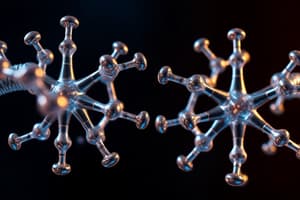Podcast
Questions and Answers
What defines a chiral center in a molecule?
What defines a chiral center in a molecule?
- A carbon atom bonded to three identical groups
- A carbon atom that is part of a ring structure
- A carbon atom bonded to four different groups (correct)
- A carbon atom involved in a double bond
Which statement correctly describes enantiomers?
Which statement correctly describes enantiomers?
- They always have the same biological activity.
- They are superimposable mirror images.
- They are not superimposable mirror images. (correct)
- They exist in different structural forms.
Which of the following statements about diastereomers is correct?
Which of the following statements about diastereomers is correct?
- They cannot be classified as stereoisomers.
- They are non-superimposable mirror images.
- They differ at one or more chiral centers but not all. (correct)
- They are identical in structure.
Why are amino acids always considered left-handed in terms of chirality?
Why are amino acids always considered left-handed in terms of chirality?
Which factor will ensure that a carbon in a ring structure can be considered a chiral center?
Which factor will ensure that a carbon in a ring structure can be considered a chiral center?
What does the designation 'D' in a Fischer projection represent?
What does the designation 'D' in a Fischer projection represent?
In a Fischer projection, how are vertical lines interpreted?
In a Fischer projection, how are vertical lines interpreted?
How is handedness determined in monosaccharides represented in Fischer projections?
How is handedness determined in monosaccharides represented in Fischer projections?
Which of the following is NOT a property of constitutional isomers?
Which of the following is NOT a property of constitutional isomers?
Which statement is true regarding stereoisomers in relation to physical properties?
Which statement is true regarding stereoisomers in relation to physical properties?
What is the term used for enantiomers that rotate plane polarized light clockwise?
What is the term used for enantiomers that rotate plane polarized light clockwise?
Which statement accurately describes the boiling and melting points of enantiomers?
Which statement accurately describes the boiling and melting points of enantiomers?
Which sugar formation involves the replacement of a hydroxyl group with an amino group?
Which sugar formation involves the replacement of a hydroxyl group with an amino group?
Which cyclic form of monosaccharides resembles a 6-membered ring?
Which cyclic form of monosaccharides resembles a 6-membered ring?
In a Haworth projection, how is the D form characterized?
In a Haworth projection, how is the D form characterized?
What type of acid is formed when a monosaccharide is oxidized with a weak oxidizing agent?
What type of acid is formed when a monosaccharide is oxidized with a weak oxidizing agent?
Which of the following statements is true about interactions between chiral and achiral molecules?
Which of the following statements is true about interactions between chiral and achiral molecules?
What is produced when the carbonyl group of a monosaccharide is reduced?
What is produced when the carbonyl group of a monosaccharide is reduced?
What is the general name for acetals formed from monosaccharides?
What is the general name for acetals formed from monosaccharides?
Which type of reaction produces phosphate esters in monosaccharides?
Which type of reaction produces phosphate esters in monosaccharides?
What type of carbohydrate contains only a single sugar unit?
What type of carbohydrate contains only a single sugar unit?
Which carbohydrate primarily serves as an energy reserve in humans?
Which carbohydrate primarily serves as an energy reserve in humans?
How many monosaccharides are covalently bonded in a disaccharide?
How many monosaccharides are covalently bonded in a disaccharide?
Which term refers to carbohydrates that cannot be digested by human enzymes?
Which term refers to carbohydrates that cannot be digested by human enzymes?
What type of isomerism occurs when molecules have the same connectivity but different spatial arrangements?
What type of isomerism occurs when molecules have the same connectivity but different spatial arrangements?
What is the basic formula that represents carbohydrates?
What is the basic formula that represents carbohydrates?
Which of the following is a structural component of nucleic acids?
Which of the following is a structural component of nucleic acids?
Which type of carbohydrate is commonly used for structural purposes in plants?
Which type of carbohydrate is commonly used for structural purposes in plants?
In which of the following classifications is glucose categorized?
In which of the following classifications is glucose categorized?
Which of the following sugars does NOT end in -ose?
Which of the following sugars does NOT end in -ose?
Which of the following statements is true about glucose?
Which of the following statements is true about glucose?
What is the composition of lactose?
What is the composition of lactose?
Which sugar is referred to as 'fruit sugar'?
Which sugar is referred to as 'fruit sugar'?
Which enzyme breaks down maltose?
Which enzyme breaks down maltose?
How is sucrose characterized in comparison to other disaccharides?
How is sucrose characterized in comparison to other disaccharides?
What distinguishes polysaccharides from monosaccharides?
What distinguishes polysaccharides from monosaccharides?
Which of the following is a characteristic of galactose?
Which of the following is a characteristic of galactose?
Which monosaccharide is a vital component of RNA?
Which monosaccharide is a vital component of RNA?
What role do polysaccharides often play in food preparation?
What role do polysaccharides often play in food preparation?
What is the primary function of glucagon in glucose metabolism?
What is the primary function of glucagon in glucose metabolism?
Study Notes
Introduction to Carbohydrates
- Most abundant class of bioorganic molecules on Earth.
- Produced by green plants through photosynthesis, primarily as cellulose (structural) and starch (energy reserve).
- Humans obtain carbohydrates mainly through dietary intake of plant materials.
Functions of Carbohydrates in Humans
- Serve as a primary energy source through oxidation.
- Store energy temporarily as glycogen.
- Provide carbon for synthesizing other biological substances.
- Form structural components of DNA (ribose, deoxyribose).
- Contribute to cell membrane structure and cell recognition processes (glycolipids and glycoproteins).
Classification of Carbohydrates
- Monosaccharides: Single sugar units (e.g., glucose, fructose).
- Disaccharides: Two monosaccharides linked (e.g., sucrose).
- Oligosaccharides: 3 to 10 monosaccharides linked.
- Polysaccharides: Many monosaccharides linked (e.g., starch, cellulose).
Monosaccharides
- Composed of polyhydroxyaldehydes or polyhydroxyketones.
- Typically contain 3 to 7 carbon atoms.
- Named with suffix –ose (exception: glyceraldehyde and dihydroxyacetone).
- Classified by carbon count (triose, tetrose, pentose, hexose) and functional group (aldose vs. ketose).
Stereoisomerism
- Isomers differ in spatial orientation.
- Chiral centers give rise to enantiomers (nonsuperimposable mirror images).
- Presence of chiral centers and structural rigidity lead to stereoisomerism.
- Constitutional isomers differ in connectivity, while stereoisomers have the same connectivity.
Chirality
- Defined by chiral centers where a carbon atom bonds to four distinct groups.
- Chiral molecules are not superimposable on their mirror images.
- Determining chiral centers requires examining molecule structure (e.g., ring systems).
Fischer Projection
- A 2D representation of chiral molecule arrangements.
- Chiral centers appear at the intersection of vertical and horizontal lines.
- Vertical lines point into the page; horizontal lines point out.
Haworth Projection
- A 2D structural notation illustrating the 3D cyclic forms of monosaccharides.
- Distinguishes between D and L configurations based on the position of the –CH2OH on C5 and the anomeric carbon (C1).
Biochemically Important Monosaccharides
- Glucose: Main energy source; also known as dextrose or blood sugar; regulated by insulin and glucagon.
- Galactose: Component of lactose and glycoproteins; synthesized in mammary glands.
- Fructose: Sweetest sugar; found in fruits and added to diets; requires less quantity for sweetness.
- Ribose & Deoxyribose: Essential components of RNA and DNA, respectively.
Disaccharides
- Formed from two monosaccharides via glycosidic linkages.
- Maltose: Composed of two glucose; derived from starch; broken down by maltase.
- Lactose: Milk sugar; composed of glucose and galactose; broken down by lactase.
- Sucrose: Common table sugar composed of glucose and fructose; non-reducing sugar, broken down by sucrase.
Polysaccharides
- Long chains of monosaccharides linked by glycosidic bonds, known as glycans.
- Generally not sweet and do not undergo Tollen’s or Benedict’s tests.
- Limited water solubility with thick colloidal properties; used as thickeners in food products.
Reactions of Monosaccharides
- Oxidation: Produces different acidic sugars based on oxidizing agents; weak agents yield aldonic acid, strong yield aldaric acid.
- Reduction: Converts carbonyl groups to hydroxyl groups, forming sugar alcohols (alditols).
- Formation of Phosphate Esters: Hydroxyl groups react with oxyacids, crucial for carbohydrate metabolism.
- Amino Sugar Formation: Replacement of hydroxyl group with an amino group, crucial for glycosaminoglycans.
- Glycoside Formation: Hemiacetals react with alcohol to form glycosides, existing in α and β forms.
Studying That Suits You
Use AI to generate personalized quizzes and flashcards to suit your learning preferences.
Description
Explore the fascinating world of chirality and isomerism found in carbohydrates. This quiz covers concepts such as enantiomers, diastereomers, and the structural features contributing to chirality. Test your understanding of chiral centers and their implications in molecular chemistry.




